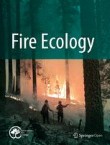Fire Ecology is the official journal of the Association for Fire Ecology.
Patterns and Trends in Burned Area and Fire Severity from 1984 to 2010 in the Sierra de San Pedro Mártir, Baja California, Mexico
Yellow pine (Pinus spp. L.) and mixed conifer (YPMC) forests of California, USA (Alta California), have been negatively affected since Euro-American settlement by a century or more of logging, fire exclusion, and...
